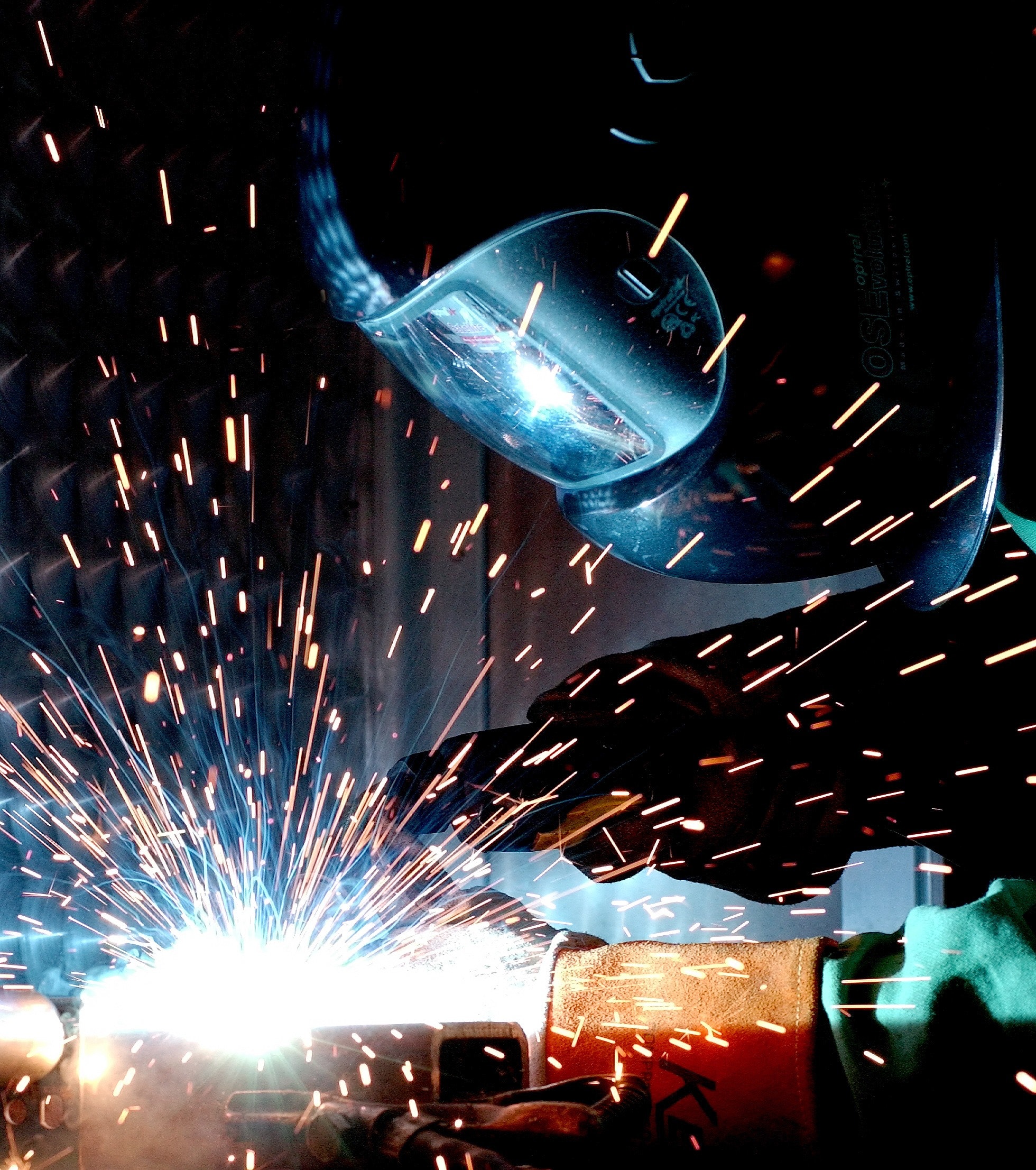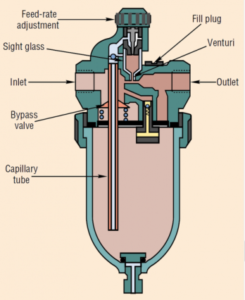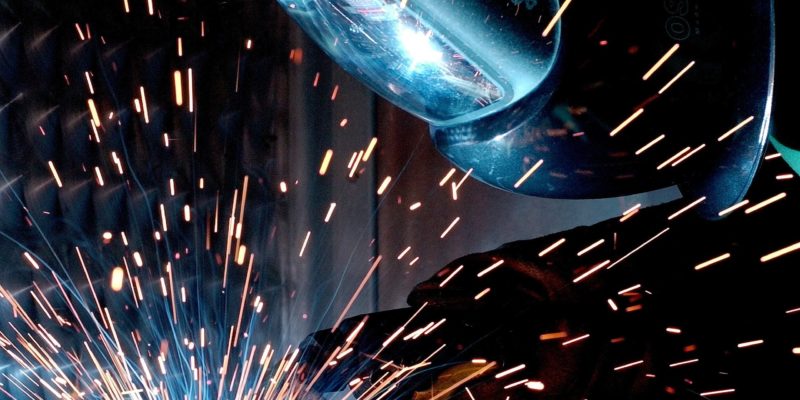
An air tool or pneumatic tool is a type of power tool driven by compressed air supplied by an air compressor. Air tools come in various shapes and sizes, ranging from small hand tools to jackhammers (paving breakers) and powerful rig mounted units used in the mining and quarrying industry. General grade air tools with a relative short life span are less expensive and are considered “disposable tools” in the tooling industry. Industrial grade pneumatic tools are amongst the most indestructible power tools available and yet many of them ‘die at a young age’. To understand why this happens one must first look at the way pneumatic tools operate.
An air compressor is the starting point for any pneumatic circuit. A compressor is a machine that converts ordinary air into compressed air as discussed in OilChat #20. The compressed air delivers potential energy (via a flexible hose) to the actuator at the business end of the pneumatic circuit. The actuator turns the potential energy stored in the compressed air back into kinetic energy and movement. In short, the actuator is the tool that does some or other useful mechanical work for us. Actuators may move back and forth in a straight line (reciprocate) or deliver a rotary motion. Linear-action (percussion) tools like jackhammers typically employ a piston-type actuator. Rotary-action tools such as air-driven drills and grinders use a geared or turbine type motor to do the job.
So what then is maiming, crippling and killing those ’indestructible’ pneumatic tools? The most lethal killer is dirty air. If the air going into the system is not properly filtered, grinding grit is introduced into the moving parts inside the actuator. Moisture is another air tool killer. If you impel wet air into a pneumatic tool, you are spraying rust-promoting water right into the guts of the tool. It is therefore good practice to fit an airline filter cum water trap between the compressor and the pneumatic tool. It removes impurities and most of the humidity (moisture) from the air in the line. Perfectly dry air is not always delivered to air tools.
The moving parts of air tools, regardless whether the tool is of a reciprocating or rotary type, require consistent lubrication just like a car engine. The problem is that air tools do not have a sump for the lubricant, so it needs to be fed into the tool with the compressed air that powers the tool. To do this airline lubricators are fitted to the air supply hose. Almost all pneumatic tools perform better when lubricated with oil. Injecting an oil mist into the air-stream lubricate valves, cylinders, and air motors for proper operation and long service life. Locating the lubricator properly in the airline is important to ensure that the correct amount of lubricant reaches the tool. Too little oil will allow excessive wear and can cause premature failure. Excessive oil in the airline is wasteful and can become a contaminant in the ambient area as it is carried out of the tool by the exhaust air.

A cross-section of a typical airline lubricator is shown on the right. Airline lubricators dispense oil from a reservoir in the lubricator into the moving airstream. As high-velocity air passes through a venturi inside the airline lubricator, it draws oil from the reservoir through a capillary tube and then drips it into the airstream. The moving air breaks the oil up into a mist or fog, which is then carried down the air line into the air-powered device. The oil feed rate can be controlled manually with an adjusting valve. A sight glass enables the operator to monitor the oil output. A filler plug allows the reservoir to be refilled in situ. Lubricators are generally selected based on pipe connection size, oil reservoir capacity and acceptable pressure loss versus flow rate. Manufacturers usually recommend a minimum air flow rate at which the venturi will function properly.
Pneumatic tools are precision built units with close tolerance parts. Many of them operate under heavy loads in adverse conditions. During operation temperatures may vary widely from low ambient to localized hot spots inside the air tool, particularly in reciprocating type tools. Boundary lubrication conditions often prevail due to the sliding action of heavily loaded pistons, which is further accentuated by their reciprocating motion. Moisture in the compressed air can cause rusting and washes the lubricant from critical areas. Adequate lubrication is therefore essential to keep pneumatic tools out of the repair shop.
To ensure extended equipment life air tool lubricants must control wear, protect against rust and corrosion, resist foaming and prevent water wash-off from critical areas when operating with wet air. In addition pneumatic tool lubricants must have low carbon forming characteristics and prevent the formation of sludge and deposits. Oil fogging can be a health hazard when working in mines and enclosed spaces and the oil must therefore also resist fogging.
The heart and weak link of pneumatic tools are the rubber “O” rings (seals) inside the tool. These need to be lubricated, but many lubricants may attack the rubber. It is thus essential to use a lubricant specifically formulated for pneumatic tools. Such oils are typically blended with highly refined mineral base oils, antiwear, oiliness and tackiness additives, emulsifiers/surfactants, rust and corrosion inhibitors plus antifoam and antifogging agents.
Equally important is the viscosity of the oil. The amount of oil picked up in airline lubricators, depends largely on the viscosity grade of the lubricant and the temperature surrounding the lubricator. Equipment manufacturers’ guidelines on viscosity selection should always be followed. In the absence of such viscosity recommendations the following ambient temperature guidelines may assist in ensuring that adequate atomization is obtained in the airline lubricator:
| – Small hand-held tools: | ISO Viscosity Grade 32 will suffice for the majority of applications. |
| – Larger industrial tools: | ISO Viscosity Grade 100 for temperatures below 20˚C |
| ISO Viscosity Grade 150 for temperatures between 20˚C and 25˚C | |
| ISO Viscosity Grade 220 for temperatures between 25˚C and 30˚C | |
| ISO Viscosity Grade 320 for temperatures between 30˚C and 35˚C | |
| ISO Viscosity Grade 460 for temperatures above 35˚C |
When operators’ health and comfort are the prime considerations when selecting air tool lubricants, grease or emulsions are often the preferred option for larger industrial tools such as rock drills operating in underground mines. Blue Chip Lubricants (Pty Ltd have a complete range of lubricants for a broad range of pneumatic tools working in a wide variety of operating conditions. Please mail us at info@bcl.co.za for details.

